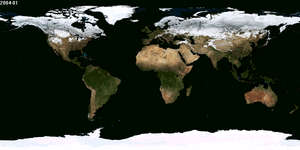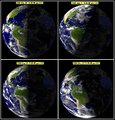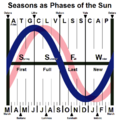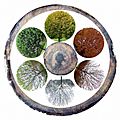Season facts for kids
A season is a special part of a year. Most places around the world have four main seasons: spring, summer, autumn (also called fall in the US), and winter.
Some areas have different kinds of seasons. For example, in tropical parts of Australia, people also talk about wet and dry seasons. These can be in addition to, or instead of, the usual four seasons.
In very warm places near the equator (tropical and subtropical areas), there are usually two main seasons: a rainy (or wet) season and a dry season. This is because the amount of rain changes a lot more than the temperature in these areas.
Summer is warm because the days are longer, and the Sun is high in the sky. This means the sun's light hits the ground more directly, making it hotter. Winter is cold because the days are shorter, and the Sun is lower in the sky. Its light hits the ground at more of an angle, making it colder.
These changes happen because the Earth's spin axis is tilted. As the Earth travels around the Sun, different parts of it get more direct sunlight. At any time, the northern and southern halves of the Earth (hemispheres) have opposite seasons. So, if it's summer in the Northern Hemisphere, it's winter in the Southern Hemisphere!
| Spring | Winter | ||
| The Seasons |
|||
| Summer | Autumn | ||
How We Measure Seasons

Scientists who study weather, called meteorologists, often define seasons by temperature. They consider summer to be the warmest three months of the year and winter the coldest three months.
Back in 1780, a group of meteorologists decided to group seasons by full months on the Gregorian calendar. This way of defining seasons is still used by weather experts all over the world today.
So, for places in the Northern Hemisphere that have four clear seasons:
- Spring starts on March 1.
- Summer starts on June 1.
- Autumn starts on September 1.
- Winter starts on December 1.
For places in the Southern Hemisphere, these dates are swapped:
- Spring starts on September 1.
- Summer starts on December 1.
- Autumn starts on March 1.
- Winter starts on June 1.
This way of defining seasons works for many areas, like New Zealand and parts of Australia.
| Northern Hemisphere | Southern Hemisphere | Start Date | End Date |
|---|---|---|---|
| Winter | Summer | December 1 | February 28 |
| Spring | Autumn | March 1 | May 31 |
| Summer | Winter | June 1 | August 31 |
| Autumn | Spring | September 1 | November 30 |
In countries like Sweden and Finland, meteorologists use a different way to define seasons. They look at the daily average temperature.
- Spring begins when the average temperature stays above 0°C (32°F) for seven days in a row.
- Summer begins when the average temperature stays above +10°C (50°F) for seven days in a row.
- Summer ends when the temperature drops below +10°C (50°F) for seven days.
- Winter begins when the temperature drops below 0°C (32°F) for seven days.
Related Pages
- Northern Hemisphere
- Southern Hemisphere
- Eastern Hemisphere
- Western Hemisphere
- Equator
- Tropic of Cancer
- Tropic of Capricorn
- Arctic Circle
- Antarctic Circle
Images for kids
-
A tropical wet season (monsoon) in Maharashtra, India.
See also
 In Spanish: Estaciones del año para niños
In Spanish: Estaciones del año para niños






